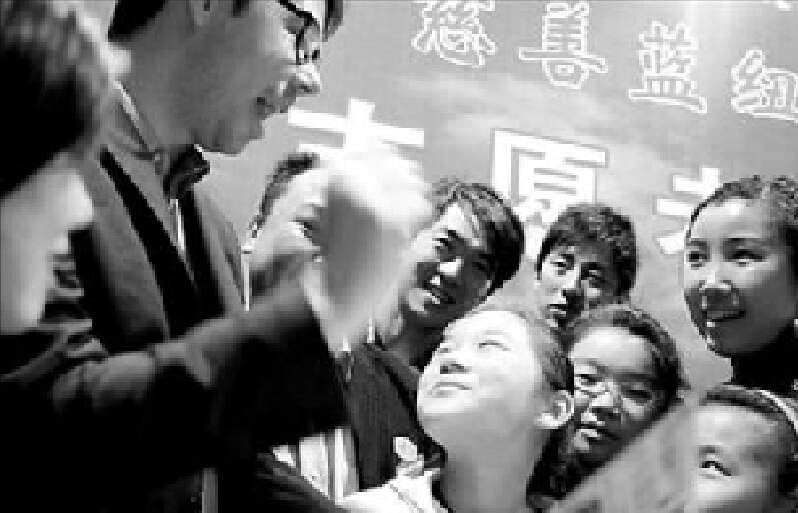Charity enters strategic phase of development in China


Volunteers interact with low-income families and tutor their children (left) A volunteer gives a haircut to an elderly woman (right).
China should attach great importance to the transformation of charity in addition to its economy, politics and culture. As a way of shaping social morality, unity and cohesion, charity contributes to easing social contradictions and conflicts.
Charity is impacted by two momentums of the development of society and economy: social structural transformation and economic system transformation. It is both an economic activity and a social activity, and is an important bridge between economy and society.
Lagging behind the economy
China is undergoing great changes in the social transition. It is transferring from an agricultural society to an industrial society, and from a society of urban-rural binary opposition to an open, integrated society. In the past, China focused more on economic construction, but now social construction is keeping pace. Wisdom and courage, calmness and patience are needed in the process of transition.
Economic development usually plays an important role in social progress. China’s transition from a planned economy to a market economy has been faster than its social structure transition. China is expected to realize its transition to a mature market economy around 2020, while its transition from a traditional social structure to a modern one will be completed after 2030. Charity, with both economic and social functions and characteristics, will of course lag behind the economy and go ahead of social structure in transition. The transition from traditional charity to modern charity will be accomplished around 2025.
Some optimistic scholars deemed that the charity transition can be realized by 2020, and it may even be accelerated through a national charity campaign. China has accumulated a certain economic capacity, and nationals have strengthened their charity awareness. Once charity law, inheritance tax and donation tax are released, the external environment of charity will be greatly improved, pushing forward the development of charity. Currently, a large amount of international and private capital has poured into the charitable sector. The charity awareness of many earlier-rich groups has been awakened.
Charity in China is still in its primary stage of development. It is unfavorable for the overall development of charity to overestimate or underestimate its developmental stage. In fact, charity has great space and potential in resolving social risks, which should be explored.
Multi-dimensional characteristics
Modern charity is characterized by continuity, transparency, standardability, requirement from internal development and push from external power.
Continuity should become one of important indicators for healthy development and the successful transition of charity. Currently, ways of management and operation, setting of projects and uncertainty of funds management have impacted charity sustainability. It should therefore become the basic principle for the transition of charity to enhance continuity and sustainability.
The main reason for low social recognition and lack of credibility in charity is insufficient transparency. Negative events emerging in recent years are caused by convert operation of charitable organizations or untimely and incomplete information disclosure. Boosting transparency has become an important expectation for charitable organizations in all walks of life.
Charity in many places needs to be urgently regulated. Scientific management and standardized operation can ensure the healthy development of charity.
Modern charity needs to be scientific, standardized and effective. This requires charity organizations to improve management styles and accelerate their upgrades.
Amid global economic integration, charity should be upgraded by accelerating transition. Meanwhile, when vulnerable groups’ basic needs are satisfied, they will inevitably have higher level of demands, which will push forward charity development.
Charity with Chinese characteristics
Compared with modern charity, traditional charity needs to be promoted in many ways. It is a long historical process for charity in China to evolve from being traditional to modern. Development of charity has a long way to go, with imbalance between social structure and economic structure as well as in social structure itself.
The new type of modern charity can rebuild ties between society and nature, individuals and society. Modern charity can give full play to advantages with Chinese characteristics and absorb modern Western experience; enhance the construction of social civilization and improve the ecological environment; ensure harmony between mankind and nature; and ensure a win-win situation between mankind and nature, mankind and society.
The relationship between mankind and society, understanding of modern social life, and rules of social functioning are basic issues for sociology. Charity is inevitably included in the range of studies of sociology. Harmonious interaction between society and mankind may be realized by revising social practice and human behavior. Concrete and historical unity of mankind and society is based on practice. According to Marxist theory, combining human objectivity with social reality through practice can result in human-free comprehensive development. Based on its national conditions, China’s charity should be conversed as follows.
Transferring to community
Low credibility and social recognition in current charity are attributed to two aspects. On one hand, the helped are mainly vulnerable groups who have weak speaking right. On the other hand, staying at the level of concept, charity is still far from the public and is not closely related to people’s genuine life. Therefore, it can neither benefit majority nor obtain people’s understanding and support.
Charity being accessible to the community conforms to psychology of the masses and Chinese traditional charitable concepts. Meanwhile, it contributes to the construction of urban and rural grassroots community which is pushing forward in China. Therefore, charity should go into the community as quickly as possible, especially into poor villages. Its quality and levels can be improved with refined and humanized services.
Transferring to development mode
Unlike “necessity charity” that only focuses on sustaining people’s basic livelihoods, “development charity” supports the poor and needy by addressing their long-term welfare. In addition, it is becoming an important way of integrating social resources, boosting social spirit, shaping social beliefs and reforming social order. Charity should advance in the direction of facilitating the whole nation’s comprehensive development on the basis of ensuring basic life of vulnerable groups.
Transferring to strategic mode
Charity should not only help the needy, but also actively help promote economic and social development as an important part of national strategy. In particular, with market effect increasingly obvious and social demands constantly upgraded, the strategic significance of Charity can’t be underestimated. Long-term development of different organizations, enterprises, communities and even the whole country should be combined with the strategic advancement of charity.
The transition from tradition to modernization is a gradual process. The establishment of a new system is based on interaction among various factors. We still have a lot of work to do to successfully realize the transition of charity.
The author is from the Center for Studies of Sociological Theory & Method of Renmin University of China.
Translated by Yu Hui
Revised by Tom Fearon
